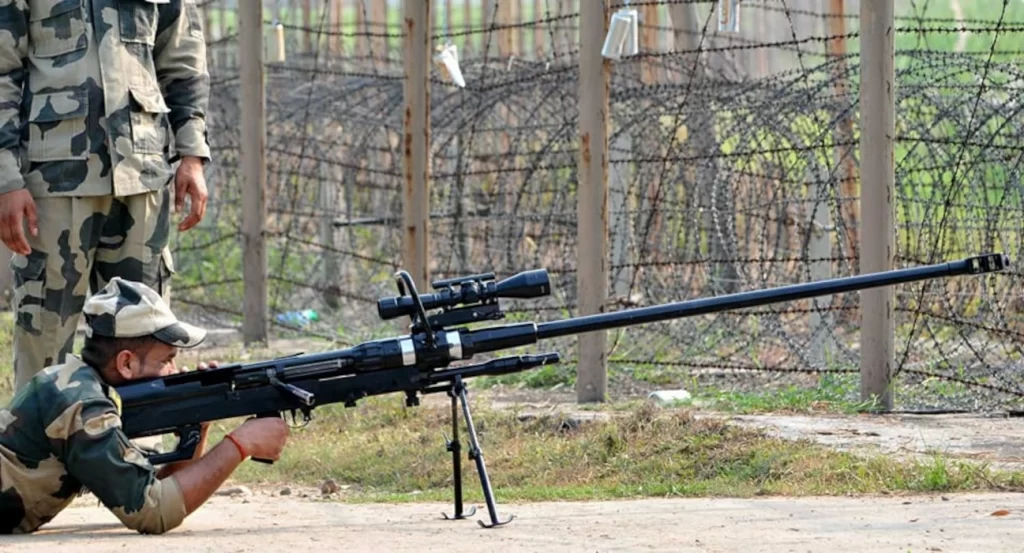An indigenously developed anti-material sniper rifle known as the Vidhwansak is currently in limited service with the Indian Army. It is speculated that the South African Denel NTW-20 served as the inspiration for its design. “Destroyer” is what the name Vidhwansak means when translated from the ancient Sanskrit language.
On the battleground, the large and heavy firing system is intended to fulfil the role of supplemental equipment capable of dealing with light vehicles, structures, enemy defences, ammo disposal, and countersniper fire.
The Indian Army began using the rifle in 2007 to fulfil its requirements for a weapon system of this kind. It is believed that approximately one hundred copies are currently in operation.
At first, the Indian Army entered into negotiations with the South African defence business Denel to determine whether or not Denel could supply the Indian Army with a choice of weaponry whenever they needed them. One of the requirements included having an anti-material rifle from the Denel NTW-20 family. The contract called for the delivery of 398 000 rounds of ammunition, 700 NTW-20 anti-material guns, and knock-down kits for an additional 300 rifles.
As soon as it was discovered that Denel had made illegal payments to the Indian government in order to acquire lucrative defence contracts, the company was immediately barred from supplying services to the Indian military. Before the ban was issued in 2005, the Army had inducted 400 guns into its inventory.
Because of this, the Indian Army was left with a variety of military deficiencies, the most serious of which was the need for a tried and tested anti-material weapon system.

As a result, the Ordnance Factory Tiruchirapalli (OFB) and the Defense Research and Development Organization (DRDO) of New Delhi worked together to develop an indigenously conceived viable alternative.
By the end of 2005, a workable prototype had been built using South African NTW-20 as a basis for further development. The evaluation started in 2006 and went well enough to result in a contract for the supply of one hundred Vidhwansak to the Indian Border Security Force (BSF). Beginning in February of 2007, the Vidhwansak series of weapons were developed, and the weapons weren’t handed over to the government until October 2008. The total number of such rifles with the BSF is not known. Another paramilitary, the Central reserve police force (CRPF), is also known to field these rifles. The Indian Army did not select the rifle due to weight issues. It weighs 25 kilogrammes, which reduces operating flexibility due to its portability.
The basic weapon system of the Vidhwansak is capable of accepting three different calibres with only minor modifications to the primary components – the barrel and bolt. In addition, the operator is allowed to instal a proper optical system for the selected calibre and is required to provide a magazine of ammunition of the relevant calibre. The ability to shoot 12.7mm, 14.5mm and 20mm ammunition makes the Vidhwansak a highly versatile tactical weapon system.
The Vidhwansak, like other heavy rifles in its class, is a manually controlled bolt action rifle. The weapon is fueled by a detachable box magazine placed into the left side of the receiver, regardless of the selected calibre.
The receiver incorporates a buffer breech to mitigate the excessive recoil common to such firearms. In addition, a muzzle brake has been installed at the end of the barrel to reduce recoil by around fifty percent. The barrel and receiver are contained within the receiver’s frame. The design of Vidhwansak allows it to be separated into two major components for transporting by two personnel.
The Vidhwansak weighs a respectable 55 pounds, measures 1700 millimetres in length, and has a barrel length of 1100 millimetres. A power-adjustable optical sight with 8×42 magnification comes as standard equipment. According to estimates, the velocity measured at the muzzle is approximately 3,411 feet per second. There is a maximum range of 2180 yards, with an effective range of 1961 yards.
The new DRDO AMR rifle
In 2020, Ordnance Factory Tiruchirappalli released a brand new indigenous anti-material weapon, which is also called Vidhwansak.
The new AMR is a large calibre sniper rifle that comes in two different calibres: 14.5 millimetres and 20 millimetres. As an anti-material weapon, the rifle can be used to destroy enemy bunkers, lightly-armoured vehicles, radar systems, parked aircraft, and a fuel storage facility, among other targets.
The weapon has a range of 1,800 metres when using a calibre of 14.5 mm, and 1,300 metres when using a calibre of 20 mm. The AMR features a magazine that holds three rounds and can be removed. The advantage of this weapon is that it can be swiftly disassembled and transported in two portable man-packs, each of which weighs between 12 and 15 kilogrammes.
The weapon’s weight is significantly less when compared to the AMR manufactured in South Africa that is currently used by the Army. The latest Vidhwansak rifle is equipped with sophisticated optical telescoping sights.
